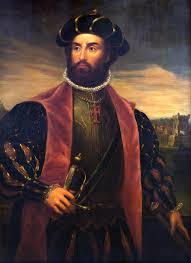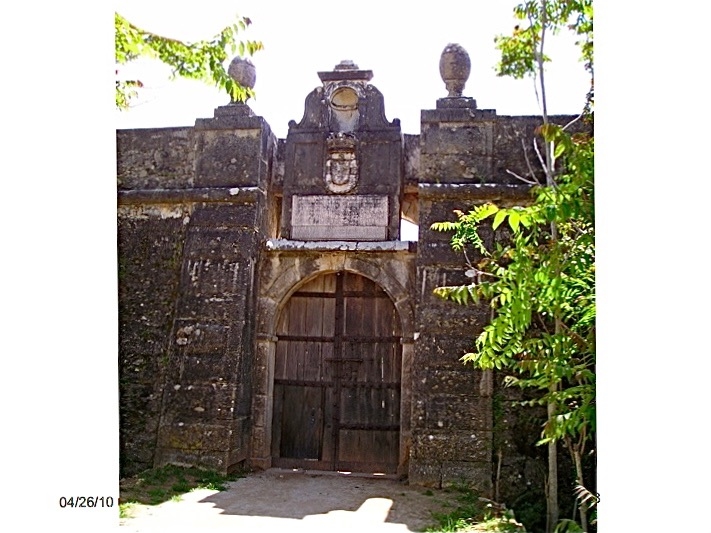Lynne Booker
When we read nowadays of acts of piracy off the coasts of Nigeria and Somalia, we cannot help feeling revulsion. But somehow piracy in history brings feelings of romantic nostalgia and it is possible to admire the swashbuckling Jack Sparrow (played by Johnny Depp) as a hero cocking a snook at authority. As we sip our piña coladas and ice cold beers and gaze over the soft blue Atlantic, it may be difficult for us to imagine the struggles of the people of the Algarve in the face of the threat of the pirate but their story is one of a fight for survival.
Pirates (or freebooters, filibusters, rovers, picaroons, buccaneers) were men who would attack anybody if they thought a profit could be made. The privateer or corsair was little different from the pirate, but possessed of government backing in the form of a Letter of Marque. In English, the word corsair usually denotes privateers from the Barbary coast of North Africa. The aim of the privateer was to attack enemy shipping as permitted in the Letter of Marque and to ransom any captives or sell them into slavery, and to sell the cargo and even the ship itself. In the 16th and early 17th centuries, the English government used privateers to attack Spanish and Portuguese treasure fleets and English heroes such as Drake, Frobisher, Hawkins, Raleigh and Grenville were all privateers acting on behalf of the government - much to the benefit of Queen Elizabeth I. Often of course out of sight of the authorities, many of their activities bordered on outright piracy.

Until 1856 when privateering was outlawed by international agreement, many governments used privateers instead of expensive commissioned warships. Portuguese privateers include Bartholomew Dias (famous for first rounding the Cape of Good Hope) and working for Prince Henry the Navigator was the Algarvian Álvaro Fernandes Palenço (who sacked and burned villages in the Canary Islands) and Vasco Anes de Corte Real from Tavira. Simão Gonçalves of Lagos was captured by the Moors, turned Muslim and captained a corsair ship. During his raid on Albufeira in 1554 he was recaptured by the Portuguese and imprisoned by the Inquisition, but released by royal order so that he could captain a Portuguese galley! The maritime traditions of the Algarve were so strong that Algarvian privateers and fishermen formed the backbone of the Portuguese maritime effort in the foundation of empire.

The history of piracy in the Algarve goes back at least to the Roman Pompey the Great, who probably founded Balsa in about 67 BC as a naval base in his campaign against the pirates of his time. Later under the Muslims, Tavira maintained itself as an independent taifa and Tavirenses led by Abdulla Ibn Ubeidala are described in Arabic sources ´a true band of pirates´. Even after the Christian reconquest, there was continued maritime trade activity between Tavira, Southern Iberia and Morocco some of which was undoubtedly piratical.
Although Portugal and England have been allies since 1386, the fact of the union of the crowns of Portugal and Spain under D Filipe I meant that war between England and Spain also meant war between England and Portugal, the ´oldest allies´. Little documented in English history books, the privateers of ´perfidious Albion´ were assiduous in attacking targets on the Spanish and Portuguese coasts. After Sir Francis Drake had ´singed the king of Spain´s beard´ (by destroying 20 Spanish ships in Cadiz harbour in 1587), he landed in the Western Algarve at Balieira, Beliche, Sagres and Cape St Vincent. On 25 May, 1587 he also made an attempt to sack Lagos, but Portuguese resistance under Fernão Teles de Meneses, Governor and Captain General of the Algarve, was too strong. On this voyage Drake terrorised other parts of the Portuguese coast and the Azores and captured the rich Portuguese Indiaman, the São Filipe. An incidental outcome of Drake´s landing at Sagres was the plan made by an unknown Englishman of the house built by Henry the Navigator at Sagres - the only near contemporary plan in existence. Between 1589 and 1591, English privateers captured 299 Portuguese ships on their return voyages from India.

A second major English attack on Cadiz was made by the Earl of Essex in 1596. The English overpowered the defences, sacked the city and stayed for 16 days. Returning from Cadiz, the English commanders decided to attack Faro. The English came ashore at Farrobilhas (now part of Quinta do Lago) on 23 July and sacked and burned Faro and stole the books of the Bishop´s library. Essex later donated the books to the Bodley´s new University Library in Oxford and they are still there! Oral history tells that some English made their way to São Brás where they were driven off by local people. The defeat of this English raid is still commemorated in the parade of tochas in São Brás every Easter Sunday.
The Algarve occupies one of the remotest corners on the continent of Europe, yet by sea it is at the junction of the busy sea lanes connecting the Atlantic Ocean with the Mediterranean Sea. It is also relatively close to the shores of North Africa. On this busy maritime corner of Europe, there were rich pickings to be had and the Sallee Rovers and the Barbary Corsairs were a constant threat not only to shipping but also to settlements along the Algarve coast. Always difficult to defend because of its distance from Lisbon, the Algarve suffered continual attacks by corsairs from the mid 16th century until 1830. As early as 1548, the Governor at Cacela, D Simão de Meneses had written to the king to complain that the tuna fishermen of Cacela, Santo António and Gomeira had been forced because of pirate attacks to move inland. Although in 1613 the king authorised all Algarvians to keep flintlocks in their houses to protect themselves from pirates, by 1620 it was becoming too dangerous for people to live in any unfortified coastal settlement. Relative safety was available in Lagos, Faro and Tavira but there are recorded instances of corsairs chasing their prey right up to the walls even of these towns.
The rocky coast of the Western Algarve provided the ideal cover for swift corsair galleys to lie in wait for tempting targets passing the cliffs of Cape St Vincent. These corsairs were after saleable goods and one of the most profitable was human. It is no longer possible to determine how many Christian Portuguese were stolen from coastal ships or from their Algarve homes to be sold in the slave markets of Sallee, Algiers, Tunis and Tripoli, but we do know that between 1607 and 1778 more than 4,500 Portuguese were ransomed from the corsairs and brought back to their native soil.
The economy of the Algarve was massively depressed by the activities of pirates, corsairs and privateers during these difficult years and tuna fishing was one activity which boomed after the corsairs disappeared in 1830. During the years of corsair activity the Portuguese state made some efforts to protect its citizens by the construction of watchtowers, forts and beacons along the Algarve coast. Some examples may still be seen, for example the Forte do Rato in Tavira, the Forte de São João da Barra at Cabanas and the Torre D´Aires near Luz de Tavira. These three structures formed part of a defensive system for the city of Tavira. All the Algarvian coastal fortifications dating from this time were constructed to deal with the threats posed by pirates. It was not until 1830, when the French Empire expanded into North Africa and deprived the Barbary corsairs of their secure bases, that the corsair threat finally disappeared.
One of the most remarkable remaining fortresses is that of São João da Barra outside Cabanas. In good repair, it was sold to a private individual in the mid nineteenth century, and now, modelled on the historic pousada idea, is a most unusual bed and breakfast establishment.

